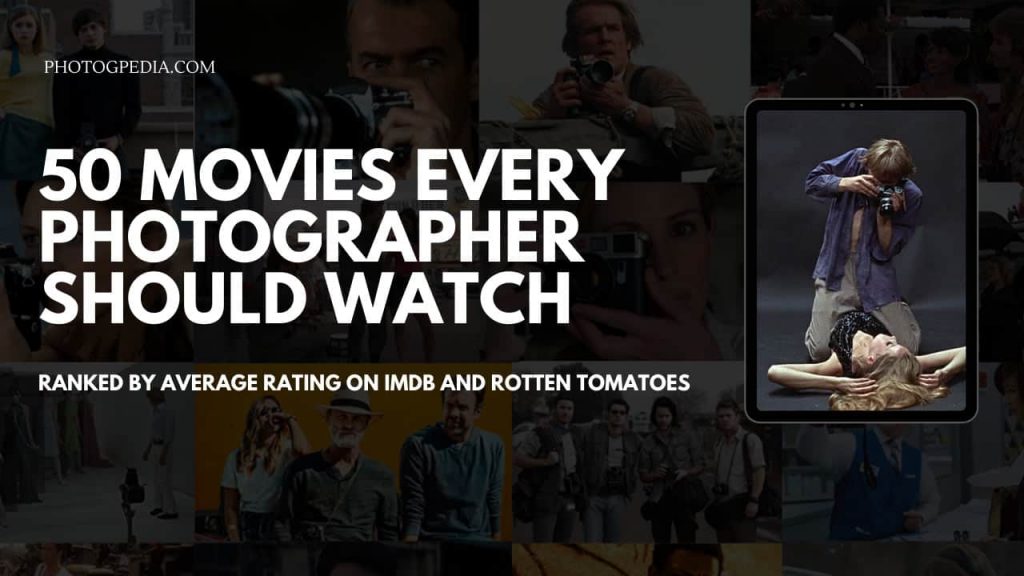Sometimes you just want to kick back, relax and watch a great movie. If you’re looking for movies that feature photography as part of the story, whether a character is a photographer, or the premise of the movie is based around photography then you’ve come to the right place.
Here, we’ve pulled together a list of our favorite photography-based movies, aimed at everyone from casual moviegoers to hardcore film buffs.
Whether you’re looking for thriller, suspense, drama, comedy or even horror, you’re guaranteed to find a great movie to watch below.
The Best Photography Movies
While there are many movies that feature photography, we’ve shortlisted the 50 we think every photographer should watch (or at least consider). Remotes at the ready…
Here’s our official list of photography movies ranked by their score (highest first) on IMDB, Rotten Tomatoes and Metacritic.
PHOTOGPEDIA Note: We have excluded all photography documentary films from this list, as we feel they deserve their own article. For documentary films, read our: Ultimate Photography Documentary List.
For information on how we rank the movies, please see notes at the bottom of the page.
Top 10 Photography Movies
1. Rear Window (1954)
Rear Window Ratings: IMDB: 8.4 – Rotten Tomatoes: 100%/9.5 – Metacritic: 100%/8.8 (Photogpedia Score: 9.2)
In Alfred Hitchcock’s Rear Window, Jimmy Stewart plays an adventure-seeking photographer who is temporarily laid up with a broken leg after injuring himself covering an automobile race for a life-like magazine.
To keep himself entertained, Stewart uses his cameras long-lens and binoculars to spy on his neighbors across the courtyard through his rear window.
With one more week left in his cast, he begins to suspect that one of his neighbors has murdered his wife and buried her in the flower bed. Slowly he draws his girlfriend (Grace Kelly) and nurse (Thelma Ritter) into his obsession and begins to sleuth out a case against the killer.
The setup is incredibly clever. Through Stewart, Hitchcock convinces us to identify with the peeper, to see what he sees. When Jeff believes that his neighbor might have killed his wife, we believe it too.
In Rear Window, Hitchcock tackles the topic of voyeurism head-on. Hitchcock understood that human beings are voyeurs by nature. When we watch a film, aren’t we looking through a window and watching people too? We look; they can’t look back. Heck, don’t some of us do the same with photography.
A thrilling watch even 66 years after it was made. At the heart of the film are the performances of Jimmy Stewart and Grace Kelly which are top-notch. Hitchcock himself has claimed that this is his most cinematic film. There’s a reason why this film is considered by many as one of the greatest ever made.
If you haven’t seen this film yet, then rent it and enjoy it… you won’t regret it.
2. Apocalypse Now
Apocalypse Now Ratings: IMDB: 8.4 – Rotten Tomatoes: 98%/9.4 – Metacritic: 94%/8.8 (Photogpedia Score: 9.0)
“Nothing else in the world smells like that. I love the smell of napalm in the morning.”
Okay, so it’s not about photography but it does feature one of the most iconic fictional photographers in movie history played by Dennis Hopper.
Francis Ford Coppola’s Vietnam War movie, Apocalypse Now, tells the story of a Special Services officer, Captain Willard’s (Martin Sheen) journey upriver to track down and kill a rogue Green Berets officer, Colonel Kurtz (Marlon Brando) who’s been taken refuge in the Cambodian jungles.
The major part of the film follows Willard and his crew as they travel to a classified location in search of Kurtz. As they move upriver, they become more and more troubled and separated from reality. In time, Willard must face the horror of the world Kurtz has created.
The movie consists of a series of set-pieces. The most famous one is the assault on the village, opening with the helicopter loudspeakers blasting Wagner’s “Ride of the Valkyries” at the terrified students and teachers. Incredible filmmaking.
Hooper delivers a short but memorable and, mostly improvised performance as a crazy photojournalist in the final third of the film.
Once you’ve watched this film, you’ll never forget it.
An epic in every way, it shames modern Hollywood’s timidity. To watch it is to feel lifted to the heights where the cinema can take you, but so rarely does.
If you’ve never watched this film, then add it to your playlist pronto and enjoy one of the best cinematic experiences you’ll likely ever have (for the best, watch 2001: A Space Odyssey.)
3. La Jetée (1962)
La Jetée Ratings: IMDB: 8.3 – Rotten Tomatoes: 92%/10 – Metacritic: N.A. (Photogpedia Score: 9.0)
What makes La Jetée so special (and the reason it’s on this list) is because the film is made up almost entirely of black and white still photographs accompanied by sound effects, music and voiceover narration.
This French short film by Chris Marker is only 27 minutes and challenges the traditional ideas of what constitutes cinema.
The film can quite hard to understand on first viewing, so here’s a quick breakdown of the story:
The film is about a man marked by an image of his childhood. It begins at an airport a few years before WW3, where we see a woman’s face at the end of the pier, followed by a reference to a death. Next, we’re in Paris in the aftermath of World War 3, where survivors rush to get underground to survive nuclear fall-out.
In the aftermath of the devastation, scientists look for a way to save humanity, and experiment with time travel, sending subjects back in time. The tests fail, until they find a man with a strong enough connection to a childhood memory – in this case, an image of a woman on a pier right before witnessing a murder. This memory allows him to slip easily into the past, and that time of his childhood.
Instead of working to save the future, he instead falls in love with the woman, and his trips back in time become romantic meetings between the two.
When the time comes for the experiment to end, he isn’t ready to give up his newfound love, but his attachment to her has dangerous consequences and leads him to shocking revelations about his own past.
If you think the story sounds familiar, then you’ve probably seen Terry Gilliam’s Twelve Monkeys which was inspired by La Jetée.
Telling a Story Through Images
Watching the film nearly 60 years after its release is a revelatory experience because there isn’t anything else quite like it out there. Where was the last time you watched a movie told through still images and voice-over narration?
Movies as we know them are a trick. They do not technically show motion, but rather show a series of individual images shown in succession, normally at a rate of 24 frames per second to give the illusion of motion. By almost entirely removing image succession (or motion) from his film, Marker challenges the idea that cinema is solely the domain of the moving image.
There is only one scene in the film which contains motion (less than 2 seconds). During a sequence, we are presented with a series of quick transitions of the woman sleeping next to her lover as we hear birds in the background. Transfixed by the stills we are caught off-guard when the woman opens her eyes and looks directly at us through the lens. Coming during the series of stills, it is an incredibly powerful visual that will haunt you for many years.
If you’re wondering what camera Chris Marker used to make the film, he used a simple Pentax Spotmatic and quite a few rolls of film. When I studied the film a few years ago I worked out that he shot less than 400 photos for the entire 27-minute film.
4. The Cameraman (1928)
Movie Ratings: IMDB: 8.1 – Rotten Tomatoes: 100%/9.4 – Metacritic: N.A. (Photogpedia Score: 8.9)
The Cameraman is a 1928 silent comedy film by Buster Keaton. In this fast-paced classic, tin-type portrait photographer Buster (Buster Keaton) falls in love with Sally who works as a secretary for the newsreel department at MGM.
Trying to win her affection, Buster abandons photography and pursues a career as a news cameraman with the inevitable catastrophic results.
The film starts slowly but gets better and better as the story moves along, leading up to a great finish that is worthy of Keaton’s comedy genius.
Visual humor does get much funnier than this. If you’ve seen any other Buster Keaton movies or any other silent comedies such as Chaplin’s, then you know that mayhem is likely to ensue at any moment.
In this film, Keaton is at the top of his game. He creates a string of wonderful gags, which are masterfully connected with a nice story and a beautiful romance with the outstanding silent movie star of the time, Marceline Day.
MGM used this film for many years as an example of a perfect comedy. The studio would get all their contracted directors and producers to watch it.
Keaton’s The Cameraman is one of his finest films. This was the first picture he made with MGM and is considered his last masterpiece. If you’ve never watched a silent movie before, then I recommend The Cameraman as a great place to start.
You can watch the film for free by clicking here or here
5. La Dolce Vita (1960)
La Dolce Vita Ratings: IMDB: 8.0 – Rotten Tomatoes: 97%/9.0 – Metacritic: 95%/8.5 (Photogpedia Score: 8.8)
Another film on the list that is considered by many as one the greatest of all-time. Federico Fellini’s 1960 film La Dolce Vita is as close to a perfect film as you can get, with maybe its only imperfection being the christening of the paparazzi.
The film follows restless journalist Marcello (Marcello Mastroianni) for seven days as he drifts through life in Rome and the “sweet life” in search of love and happiness.
Marcello contends with his suicidal girlfriend, whilst also pursuing heiress Maddalena (Anouk Aimée) and movie star Sylvia (Anita Ekberg), embracing a hedonistic and carefree approach to living.
Told in a brilliant episodic structure, this fascinating three-hour character study combines art and box office in one remarkable film. This is existential filmmaking at its best. The cinematography is stunning, and the streets of Rome look breathtaking in black and white.
Who can also forget the iconic scene in the film when Marcello and actress Sylvia (Anita Ekberg) splash around together in the famous Trevi Fountain at dawn.
Paparazzo
Why’s it on the list? In the film, Walter Santesso plays an annoying, celebrity-hounding photographer nicknamed “Paparazzo.” If it wasn’t for this film the word paparazzi wouldn’t exist today and modern-day paparazzi would be called something else instead.
The film also influenced modern-day classics such as Sofia Coppola’s Lost in Translation, Woody Allen’s Celebrity and Tarantino’s Pulp Fiction.
This is a film you’re either going to love or hate. Some people have called it a masterpiece, whilst others have called it boring and pretentious. One thing is for sure though, this is Fellini’s greatest film, and one of the most important films of the 1960s.
La Dolce Vita should be on the to watch list of all photographers today.
6. Memento (2000)
Memento Ratings: IMDB: 8.4 – Rotten Tomatoes: 92%/9.4 – Metacritic: 80%/8.9 (Photogpedia Score: 8.7)
Next up, we have Christopher Nolan’s brilliant thriller Memento. Although it’s not a film that is themed around photography, it does use photographs throughout to help advance the story.
This movie, about one man’s pursuit for vengeance, does everything a thriller is supposed to do: intrigues, involves and keeps you guessing. Nolan’s jigsaw puzzle of a movie grabs you and won’t let you go.
The stunning opener involves a murder and a Polaroid of the body. Then everything runs backwards. The polaroid slips back into the camera, a bullet returns to the gun barrel, and Leonard starts living in reverse.
Leonard Shelby (Guy Pearce), a former insurance investigator, struggles to put his life back together after the rape and murder of his wife. The problem is he suffers from anterograde amnesia (loss of short-term memory) as a result of being beaten severely by the same man who killed his wife.
Incapable of retaining any new information, Leonard resorts to writing notes and taking Polaroids to keep track of what happens to him over a day.
Leonard is sure that the culprit still walks the streets, and becomes obsessed with taking revenge against the man who ruined his life, and sets out to find him.
The Twist Beginning
Through clever storytelling, Nolan keeps you guessing with every scene. As Memento is told in reverse, instead of a twist ending we get a twist beginning. His reverse action isn’t just a trick – it’s a way to put us inside Leonard’s head. Memento is a movie that demands we trust no one.
If you’re anything like me, you won’t catch all the nuances in this film, and the ending the first time you watch it. Repeat viewings are necessary.
7. Roman Holiday (1953)
Movie Ratings: IMDB: 8 – Rotten Tomatoes: 98%/9.4 – Metacritic: 78%/8.4 (Photogpedia Score: 8.6)
William Wyler’s, Roman Holiday remains the gold standard for romantic comedy films. In this timeless classic, Audrey Hepburn makes her screen debut as Princess Ann in the female lead, alongside Gregory Peck.
Overwhelmed by her touring schedule, Princess Ann (Hepburn) takes off for a night while in Rome. When a sedative she was given by her doctor kicks in, she falls asleep on a street bench and is found by an American reporter, Joe Bradley (Peck), who reluctantly takes her back to his apartment for safety.
It isn’t until the next day when a press conference scheduled with the princess is canceled, does he realize the identity of his guest.
Knowing how much an exclusive scoop on the Princess is worth, Joe enlists the help of Irving, his photographer friend and embarks on a fun-seeking tour of Rome with the princess.
Joe hides that he’s a reporter and poses as a fertilizer salesman to get the inside scoop on the princess’s innermost desires, her views on world affairs, and her thoughts on fashion (which are worth the most, of course). While Joe’s snapper buddy Irving sneaks’ pictures of Ann smoking, riding a scooter and dancing. This task does nothing but help the humor of the film as he captures several fast-paced moments without bringing up even the slightest bit of suspicion.
The film features several wonderful scenes including Hepburn and Peck fooling around at the Mouth of Truth (Bocca della Verità).
Princess Audrey
It was nominated for ten Academy Awards and won three of them for best leading actress, best costume design and best screenplay.
Roman Holiday is a wonderful story, and Hepburn’s performance as the charming and beautiful Princess is what places this film amongst the very best.
8. Boyhood (2014)
Movie Ratings: IMDB: 7.9 – Rotten Tomatoes: 97%/8 – Metacritic: 100%/7.6 (Photogpedia Score: 8.5)
Boyhood is an extraordinary landmark film as it was shot in 39 days and filmed over 12 years from 2002 to 2014, so the characters age naturally, which makes the movie more realistic.
The film follows the life of six-year-old Mason (Ellar Coltrane) from childhood to his teenage years and eventually graduating high school. The movie focuses on the effects of family arguments and domestic abuse. It also conveys how an individual can come of age and mature before time by witnessing too many emotionally painful events and constantly being on the move.
Photography plays a small but important role in the films final act and provides somewhat of a rewarding conclusion to this near three-hour family drama.
I think what appeals to most people with the film is the concept and incredible achievement of Linklater to shoot the film over twelve years.
But the problem is, it’s a film about nothing. I watched the film waiting for something to happen, but the only outrageous thing Mason did was smoke a cigarette at 15.
I think more than anything your enjoyment of the film comes down to how you relate to Mason’s story.
Reality or Fiction
Many people have praised this movie for its normality or for being close to real life. Watching paint dry and standing in the line in the supermarket is real life too but it doesn’t make for an entertaining movie.
For me, Boyhood felt like watching a home movie about someone I don’t know and don’t care about.
Except for Ethan Hawke in the role of Mason’s father, the acting also came across as lackluster and wooden. I guess that’s the risk you take when you cast young actors and stay with them for twelve years.
It’s got some great reviews, but these are mainly from critics. It’s also got some awful reviews. Like all films though, it’s subjective and comes down to your own taste.
Watch the film and make up your own mind – just don’t blame me if you fall asleep after twenty minutes.
9. Peeping Tom (1960)
Peeping Tom Ratings: IMDB: 7.7 – Rotten Tomatoes: 96%/8.5 – Metacritic: N.A. (Photogpedia Score: 8.4)
Few films have had as devastating an effect on the career of a renowned director as Peeping Tom had on Michael Powell.
In the 1950s, Powell was one of Britain’s most respected and beloved filmmakers, however, this all changed in 1960, with the release of Peeping Tom – a horror-thriller that marked a surprising change of direction for the director.
Warped by early childhood experiences at the hands of a sadistic father, an amateur filmmaker and a part-time taker of glamour pictures, Mark Lewis (Carl Boehm) delights in murdering women while filming them. His desire to capture fear on film becomes derailed when he takes up with an innocent girl (Anna Massey) who lives downstairs.
Critics unanimously loathed the film and so scathing were the reviews that Powell found himself blacklisted and cast out into film wilderness.
Peeping Tom and Scorsese
The film was released the same year as Psycho, but it wasn’t until its re-release in 1979 (with the influence of Martin Scorsese) that it finally got the recognition it deserved.
Martin Scorsese, once remarked: “I have always felt that Peeping Tom and [Fellini’s] 8½ say everything that can be said about filmmaking, about the process of dealing with film, the objectivity and subjectivity of it and the confusion between the two. Peeping Tom shows the aggression of it, how the camera violates.”
Peeping Tom holds a coveted place in cinema history as the first film to tell the story from the killers’ point of view, as well as being the first real slasher film (Psycho was released a month later.) Peeping Tom may not be quite on the same level as Hitchcock’s masterpiece, but it may well be its equal in terms of influence.
Although not scary or shocking by today’s standards, it’s still a pretty disturbing psychological horror and an enjoyable watch for fans of the genre. Few films about voyeurism have been this good.
If you consider yourself a film buff, then Peeping Tom needs to be added to your list of films to watch.
10. Full Metal Jacket (1987)
Movie Ratings: IMDB: 8.3 – Rotten Tomatoes: 91%/9.4 – Metacritic: 76%/7.3 (Photogpedia Score: 8.3)
Next on the list, we have Stanley Kubrick’s superbly made Vietnam War film, Full Metal Jacket.
The film is divided into two parts. The first 44 minutes revolves around the training of marines and shows the brutality of becoming a soldier, while the remaining 72 minutes focus on the actual battlefield and the terror of war.
In the first half of the film, the ruthless drill instructor, Hartman (Ermey) molds a group of recruits into combat-ready Marines. His message is simple: thinking is a vice and killing is a virtue. This chapter of the story mainly follows Joker (Modine) and Pyle as they battle through the training.
The second half of the film opens with a shot of a mini-skirted Vietnam hooker propositioning Joker (now a behind-the-lines Stars and Stripes reporter) and his photographer Rafterman. Seeking first-hand action to report on, Joker and Rafterman go out into the field and follow an infantry squad in Hue during the Tet Offensive.
Full Metal Jacket has plenty of great moments and memorable lines of dialogue. Ermey’s opening speech to his recruits is one of them. The footage on the Paris Island obstacle course is also powerful. Finally, you have the action sequence of the men chasing down the sniper in the film’s finale.
The Vision of Kubrick
Kubrick knew how to shoot a movie better than anybody else. If you pause the movie at any point, not only will the frame be visually stunning and perfectly composed, but it will also tell a story.
Stanley Kubrick’s incredible direction along with several unforgettable characters makes this a must-see film. This is one of the best Vietnam War films, rivaled only by Francis Ford Coppola’s Apocalypse Now.
Full Metal Jacket is a film that everyone should see at least once, although like other Kubrick films it gets better with every viewing. A remarkable movie and one that you’ll never forget.
11. The Killing Fields (1991)
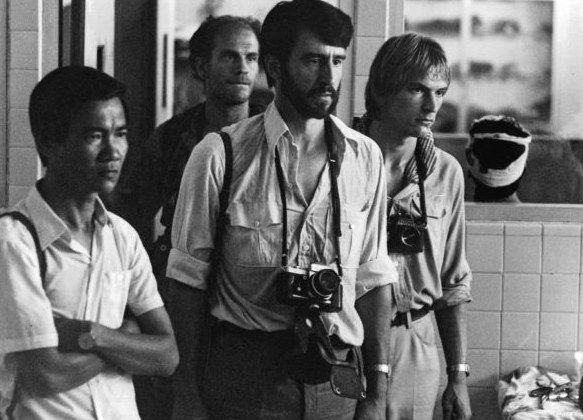
Movie Ratings: IMDB: 7.8 – Rotten Tomatoes: 93%/9.2 – Metacritic: 76% (Photogpedia Score: 8.2)
The Killing Fields is a 1984 biographical drama about the Khmer Rouge regime in Cambodia, which is based on the real-life story of two journalists: American Sydney Schanberg and Cambodian Dith Pran.
In 1975, New York Times reporter Sydney Schanberg (Sam Waterston) is on assignment covering the Cambodian Civil War, with the help of local journalist and interpreter Dith Pran and American photojournalist Al Rockoff (John Malkovich). When the U.S. Army pulls out amid escalating violence, Schanberg arranges for Pran and his family to exit safely from the region. Pran, however, tells Schanberg he intends to stay in Cambodia to help cover the unfolding story.
The Killing Fields is a powerful and compelling story that is well directed by Roland Joffé. There’s also a fascinating scene centered around the development of film that anyone who shoots film will enjoy.
12. City of God (2002)
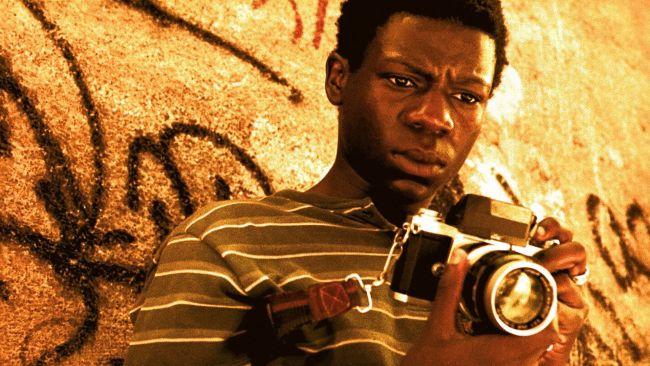
Movie Ratings: IMDB: 8.6 – Rotten Tomatoes: 90%/8 – Metacritic: 72%/7.4 (Photogpedia Score: 8.1)
City of God is a Brazilian thriller that’s loosely based on a semiautobiographical novel with the same name originally published in 1997. Part coming-of-age movie, part crime-drama, the film centers around two friends in the poverty-stricken favelas of Rio de Janeiro in the 1970s.
The main character of the story is Rocket, a budding press photographer who documents the drug-related violence of his neighborhood. His friend José “Zé” Pequeno is an ambitious drug dealer who uses Rocket and his photos as a way to increase his fame as a turf war erupts with his rival.
City of God is a sweeping tale of how crime affects the poor population of Rio de Janeiro. Not an easy film to watch, but then again it shouldn’t be. This unique film was shot on location in Rio’s poorest neighborhoods. As a result, City of God plays more like a documentary than a movie.
This is also another film where audience opinion is divided. It’s one of those films that I found interesting to watch, but not something I would ever return to again.
13. Carol (2015)
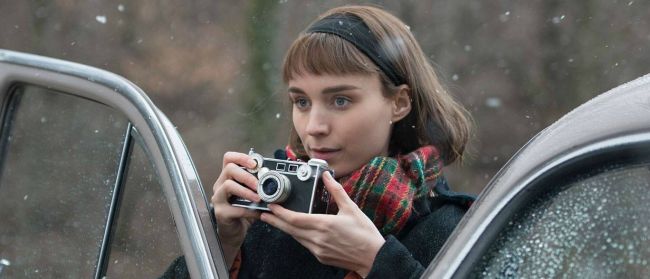
Carol Ratings: IMDB: 7.2 – Rotten Tomatoes: 94%/7.4 – Metacritic: 95%/7.9 (Photogpedia Score: 8.1)
Based on the 1952 novel The Price of Salt by Patricia Highsmith, Carol tells the story of a forbidden affair between Therese (Rooney Mara) an aspiring photographer, who works at a department store in Manhattan and an older woman, Carol (Cate Blanchett) who’s going through a difficult divorce.
While not a film for everyone, I did get caught up in the films deliberate pacing, characters, and story. The best thing about the film is the outstanding performances from the leading ladies especially Rooney Mara.
14. Salvador (1986)
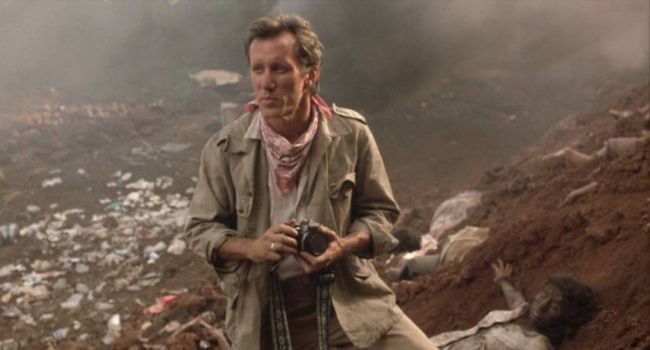
Salvador Ratings: IMDB: 7.4 – Rotten Tomatoes: 88%/8.6 – Metacritic: N.A. (Photogpedia Score: 8.1)
American photojournalist Richard Boyle (James Woods) is unable to find work because of his penchant for booze and drugs, so he heads to El Salvador with his DJ friend Doctor Rock (James Belushi) to see if he can get a gig covering the country’s ongoing civil war. When the violence escalates, he decides it’s time to flee the country, but his relationship with an El Salvadorian woman complicates matters.
Although not really a film about photography, we do get some insight into what drives war photographers and there’s lots of chat about the iconic photographer Robert Capa.
There’s plenty of substance with the story, but Stone’s choice of shooting it like a documentary leaves the tone of the movie floundering. Regarded by many as one of Oliver Stone’s best movies, I think that says more about his lack of filmmaking ability rather than how good this film is.
15. Bridges of Madison County (1995)
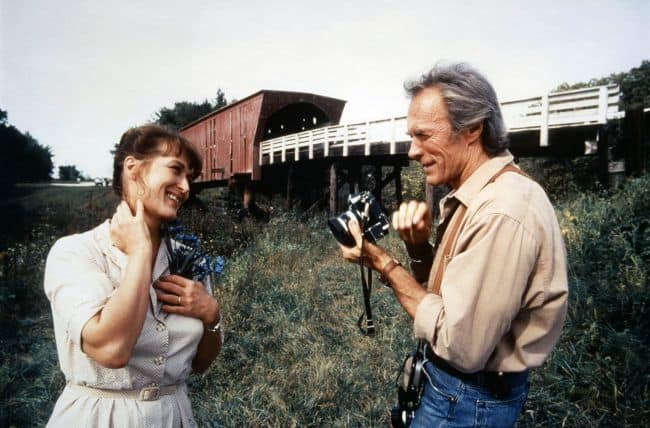
Bridges of Madison County Ratings: IMDB: 7.6 – Rotten Tomatoes: 90%/8.7 – Metacritic: 66%/8.8 (Photogpedia Score: 8.1)
Based on the best-selling book by Robert James Waller Bridges, Madison County is a gentle drama about a housewife who meets a globetrotting photographer.
The story begins as photographer Robert Kincaid (Clint Eastwood) journeys to Madison County in the fall of 1965 to photograph its rustic covered bridges for National Geographic. Upon his arrival, he stops by an old farmhouse to ask directions. There he encounters housewife, Francesca Johnson (Meryl Streep), whose husband and two children are out of town attending the Illinois State Fair. They then begin a four-day affair and a relationship that changes them both forever.
Bridges of Madison County is an old-fashioned love story that explores the theme of forbidden love. I’ve watched it several times now and it never gets old. From the wonderful performances of Meryl Streep and Clint Eastwood to the beautiful cinematography and film score.
This only two criticisms I have are there are too many unnecessary dissolves in the film and I would have liked to have seen the photos from the photobook at the end of the film, apart from that though, Bridges of Madison County is an absolute treat from start to finish.
16. Everlasting Moments (2008)
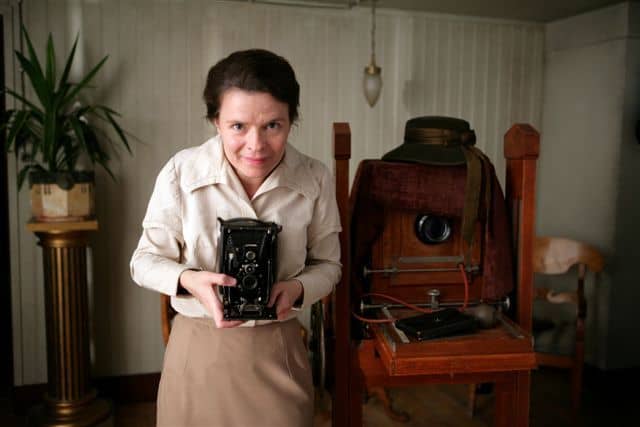
Movie Moments: IMDB: 7.5 – Rotten Tomatoes: 90%/8.4 – Metacritic: 80%.7.4 (Photogpedia Score: 8.0)
Everlasting Moments is a Swedish drama set in the early 1900s based on the true story of Maria Lawson.
Maria wins a camera in a lottery but is far too busy working to think about photography. So, Maria tries to sell the camera to a local photographer, but he insists she tries it first and offers her some useful tips. It’s the beginning of a beautiful friendship between the two and one that changes her life.
The film is slow-paced but beautifully shot. The problem with Everlasting Moments is it’s a little bit dull and comes across like a BBC period adaptation. However, if you’re a fan of good old-fashioned storytelling then you’ll find plenty to enjoy with the film.
17. Proof (1991)
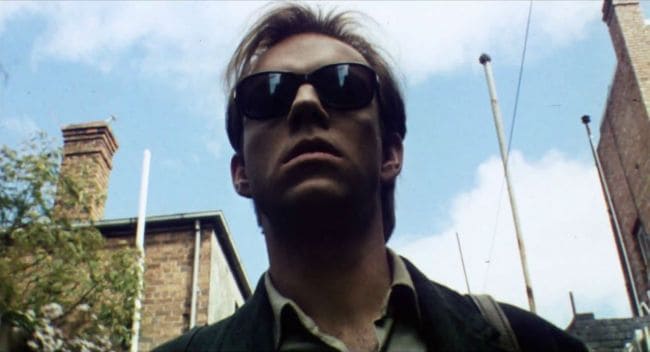
Movie Ratings: IMDB: 7.2 – Rotten Tomatoes: 94%/8 – Metacritic: N.A. (Photogpedia Score: 8.0)
Proof is an excellent Aussie black comedy that features terrific performances from both Hugo Weaving and Russell Crowe.
Martin (Hugo Weaving) a blind photographer with trust issues uses his camera to record places he visits, then asks people to describe them to him. His lack of trust, which runs so deep it has defined his entire life and personality, began in childhood.
His housekeeper, Celia (Genevieve Picot) is the only other person in his life and tries to seduce him. With no other way of getting his attention, she manipulates him. When Martin befriends Andy (Russel Crowe), a dishwasher at a restaurant with a talent for description, Celia becomes jealous.
Jocelyn Moorhouse uses the unusual premise of a blind photographer to explore issues of trust, friendship, obsession and the nature of truth and reality. Proof works because Moorehouse keeps the story simple and relies heavily on the obvious subtext to do her work for her.
18. Blow-Up (1966)
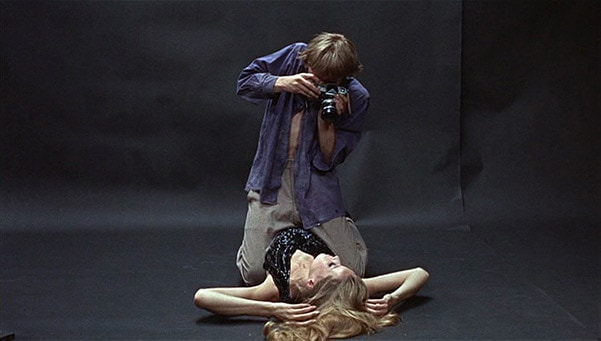
Blow Up Ratings: IMDB: 7.6 – Rotten Tomatoes: 87%/8.4 – Metacritic: 82%/7.0 (Photogpedia Score: 7.9)
Blow-Up was Michelangelo Antonioni’s first English language film and also his only box office hit. This 1960s film was inspired by the life of an actual “Swinging London” photographer, David Bailey and based on a story by Argentine novelist Julio Cortázar.
Thomas (David Hemmings), a London fashion photographer notices something in the background of one of the photos he has taken in the park one afternoon. Blowing up the negatives, he believes he has either photographed an attempted murder or an actual murder. The photos lead to a quest to match his notion of photographic truth to reality.
The last scene poses a profound and beautiful question about photography, the art of storytelling, and life itself. The film reminds us that even the latest technologies can mislead or betray us.
What’s often overlooked with this film is how well Antonioni used sound to create atmosphere. Antonioni liked to control the environment around him to tell his stories and this is demonstrated wonderfully in Blow-Up. Often in Antonioni’s films, a street corner will stay in a shot long after the characters have left the frame. It is as though the imprint of the story is still there and he lets us wait.
The film has lagging moments and is a bit rough in places by today’s standards, but if you look beyond that then you’ll find a treasure of a film that is beautifully shot and has some excellent performances. This is an entertaining movie and in my opinion, deserves to be much higher on this list.
19. The Omen (1976)
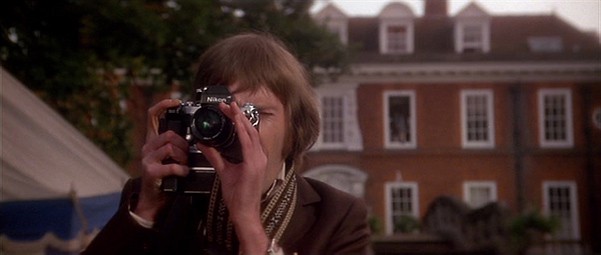
The Omen Ratings: IMDB: 7.5 – Rotten Tomatoes: 85%/8 – Metacritic: 62%/7.9 (Photogpedia Score: 7.6)
This horror classic features some of the most memorable and terrifying images you’ll ever see in a movie.
Gregory Peck stars as American diplomat Robert whose wife Katharine (Lee Remick) has just given birth to a stillborn child. Shortly after he is approached by a priest who suggests that they take a healthy newborn whose mother has just died in childbirth. Without telling his wife he agrees.
After the family moves to London, a sinister series of events start to occur. During Damien’s fifth birthday party, the family’s nanny hangs herself in front of everyone. In the background, a news photographer named Keith Jennings (David Warner) takes pictures.
As more people die, Robert begins to investigate Damien’s background and soon realizes his adopted son may be the devil incarnate.
The Omen is a suspenseful and terrifying take on the antichrist and is considered to be one of the greatest horror films of all time. This movie also has one of the most chilling background scores in the history of cinema.
The photographer character played brilliantly by David Warner plays an important role in the film.
20. Funny Face
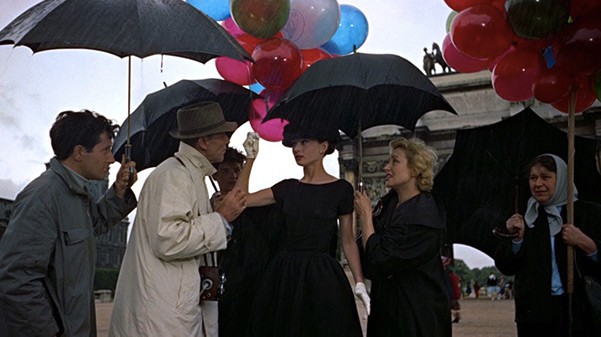
Movie Ratings: IMDB: 7.0 – Rotten Tomatoes: 86%/8.1 – Metacritic: 7.3 (Photogpedia Score: 7.6)
Funny Face is a charming and breezy musical starring Audrey Hepburn and Fred Astaire.
In the film, Astaire plays fashion photographer Dick Avery who was based on the legendary Richard Avedon. In the search for an intellectual backdrop for his air-headed model, he commandeers a Greenwich Village bookstore much to the dismay of the store clerk Jo Stockton (Hepburn).
Later, when Dick examines the photos, he becomes fascinated by Jo’s unique look and her “funny face” as is Maggie Prescott, the editor of a leading fashion magazine. They offer Jo a modeling contract, which she reluctantly accepts only because it includes a free trip to Paris.
Once in France, Avery snaps more pictures of Jo against iconic Parisian backdrops. In the process, they fall for one another, only to find hurdles in their way.
For me, the musical numbers were far too frequent and over the top for my taste. There are only two scenes from Funny Face I would watch again: Audrey Hepburn dancing in the café and the photoshoot sequence in Paris (which is a must-watch for all photographers).
For fans of musicals and Audrey, Funny Face is a must-see. For those who want to see great photography in a movie, skip to ahead to the photoshoot scenes 57 minutes into the film.
Richard Avedon was hired by Paramount as a consultant for the film and took all the stills you see in the picture. The photo sequence in Paris landmarks has never been topped.
21. Under Fire (1983)
Movie Ratings: IMDB: 7.0 – Rotten Tomatoes: 90%/6.1 – Metacritic: N.A. (Photogpedia Score: 7.5)
Under Fire is a political thriller about a seedy photojournalist, Price (Nick Nolte) during the Nicaraguan Revolution in 1979. Price is joined by TV anchor, Grazier (Gene Hackman) and Cassidy (Joanna Cassidy) a radio reporter. The three reporters become involved in a romantic triangle as they chase down the story during the last days of the corrupt Somoza regime. The film’s story was inspired by the real-life murders of reporter Bill Stewart and his translator Juan Espinoza by National Guard forces.
22. The Year of Living Dangerously (1982)
The Year of Living Dangerously Ratings: IMDB: 7.1 – Rotten Tomatoes: 87%/7.7 – Metacritic: 65%/7.7 (Photogpedia Score: 7.5)
In this Australian romantic drama, Hamilton (Mel Gibson), a young wire service reporter tries to navigate the political turmoil of Indonesia during the rule of President Sukarno in the ‘60s with the help of diminutive photographer Billy (Linda Hunt). As Jakarta sinks into disarray, Hamilton pursues a romance with British attaché Jill Bryant (Sigourney Weaver) who has two weeks left on her tour.
23 Closer (2004)
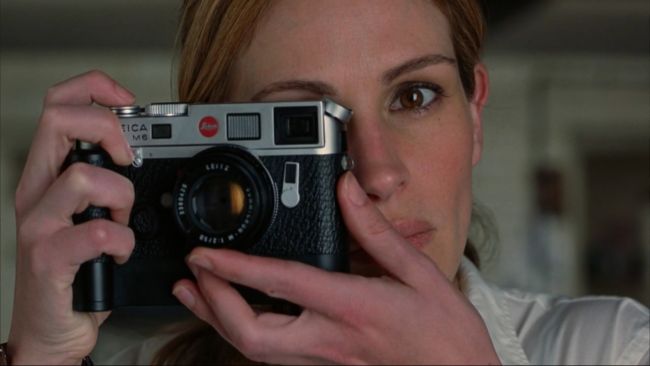
Closer Ratings: IMDB: 7.2 – Rotten Tomatoes: 68%/8.1 – Metacritic: 65%/8.8 (Photogpedia Score: 7.4)
Closer is a romantic drama about the intertwining relationships of two couples living in London. Anna a successful photographer (Julia Roberts) and a recent divorcee meets Dan (Jude Law), an aspiring novelist when she takes his picture. She becomes romantically involved with him and begins an affair that continues secretly even after her marriage to Larry (Clive Owen). Natalie Portman also features in the film as Alice, a waitress turned stripper.
Although there’s not a lot of photography, there is a couple of scenes where Anna is working in her studio. Also, watch out for the brilliant online chat exchange between the two men.
24. High Art (1998)
High Art Ratings: IMDB: 6.6 – Rotten Tomatoes: 73%/7.7 – Metacritic: 73%/8.6 (Photogpedia Score: 7.4)
An independent art-house film, High Art is about an intern (Radha Mitchell) at a photography magazine who falls for a drug-addicted photographer (Ally Sheedy). As their relationship develops, they both attempt to use the other to advance their careers. Despite excellent acting from the two female leads, the film is a little dull and comes across a bit too pretentious for my liking. Watch the trailer first and see whether it’s something that appeals to you.
25. Photographing Fairies (1997)
Photographing Fairies Ratings: IMDB: 6.8 – Rotten Tomatoes: 82%/7.4 – Metacritic: N.A. (Photogpedia Score: 7.3)
In Photographing Fairies, a recently widowed photographer makes his living disproving the authenticity of photographs of supernatural phenomena. When a woman shows him, a photograph taken by her daughters of fairies in her garden, the man declares the image genuine. He decides to investigate further and what he finds surprises him.
The film is based on a novel by Steve Szilagyi, which in turn was based on the true story of the Cottingley Fairies, in which two Yorkshire girls claimed they had played with and photographed fairies in their garden.
Expert analysis of the negatives failed to disprove their claims, and even Arthur Conan Doyle (Sherlock Holmes creator) became convinced by the story – much to his embarrassment when the two women later admitted it was a hoax. It just goes to show that photo manipulation is nothing new.
25 More Photography Movies
26. The Serpent (2006)
The Serpent Ratings: IMDB: 6.5 – Rotten Tomatoes: 85%/6.9 – Metacritic: N.A. (Photogpedia Score: 7.1)
A French thriller based on the 1971 novel Plender by Ted Lewis, The Serpent tells the story of Vincent, an introverted fashion photographer in the middle of a difficult divorce. If things weren’t bad enough, an old friend sets him up with a prostitute in an attempt to blackmail him. It’s an okay thriller that starts well but loses its way halfway through.
27. Double Exposure: The Story of Margaret Bourke-White (1989)
Movie Ratings: IMDB: 7.1 – Rotten Tomatoes: N.A. – Metacritic: N.A. (Photogpedia Score: 7.1)
Double Exposure is a made for TV biopic about Margaret Bourke-White, America’s first female war photojournalist and the first foreign photographer to take pictures of the Soviet five-year plan. She even provided the cover image for the first-ever issue of Life magazine.
The film is structured around the story of Bourke-White’s career and her rocky relationship with her second husband. There’s not too much information about her early life or how she got started in photography, so the film feels a little incomplete. Farrah Fawcett gives a solid performance as Bourke-White though.
28. Eadweard (2015)
Eadweard Ratings: IMDB: 6.3 – Rotten Tomatoes: 7.9 – Metacritic: N.A. (Photogpedia Score: 7.1)
Eadweard is a Canadian drama about the turn of the century photographer Eadweard Muybridge, who famously took 12 still images of a horse galloping and combined them in a prototype film reel, to prove that all four feet leave the ground at the same time.
29. The Big Picture (2010)
Movie Ratings: IMDB: 6.7 – Rotten Tomatoes: 86%/6.3 – Metacritic: 71%/6.5 (Photogpedia Score: 7.0)
The Big Picture is a French thriller adapted from Douglas Kennedy’s 1997 novel of the same name. After a successful lawyer accidentally kills his wife’s lover, a local photographer, he fakes his death and starts a new life on the coast taking up the dead man’s identity.
30. Shutter (2004)
Shutter Ratings: IMDB: 7.1 – Rotten Tomatoes: 58%/7.8 – Metacritic: N.A. (Photogpedia Score: 7.0)
After killing a young woman in a hit and run, Jane and her photographer boyfriend, Tun begin seeing a shadowy figure haunting the background of his photographs. Concerned that the anomaly is the vengeful spirit of the young woman, Jane does some research and soon discovers the woman was a classmate of Tun’s. As the haunting continues, Jane uncovers a shocking secret.
Be sure to watch the original Thai version of the film, not the crappy 2008 starring Joshua Jackson. I’ve watched both, and the original is much better.
31. Delirious (2006)
Delirious Ratings: IMDB: 6.5 – Rotten Tomatoes: 82%/5.7 – Metacritic: 68%/7.6 (Photogpedia Score: 6.9)
Steve Buscemi stars as a small-time neurotic celebrity photographer who takes a homeless wannabe actor and makes him his assistant. Their friendship begins to strain when his new assistant gets involved with a pop star.
What should be a fun satire on paparazzi and celebrity life, is let down by a poorly written script. Buscemi and Michael Pitt work well together but apart from that, this film doesn’t have much else going for it.
32. A Thousand Times Good Night (2013)
Movie Ratings: IMDB: 7.1 – Rotten Tomatoes: 71%/6.5 – Metacritic: 67%/6.8 (Photogpedia Score: 6.9)
A Thousand Times Good Night is about a war-zone photojournalist (Juliet Binoche) whose obsession with reporting in dangerous places puts her at odds with her family. After a near-death experience on assignment, her husband gives her an ultimatum to give up her work or risk losing her family.
Although fictional, a lot of the material comes from the director Erik Poppe’s own experiences as a photojournalist in the ‘80s, covering conflicts in Asia, Central America, and Africa.
Binoche is wonderful as Rebecca, a woman divided by her love of her job and the love of her family. Unfortunately, the film is let down by awful writing and horrible pacing. Yeah, there are some nice shots in the film, but if the director spent more time focusing on the story and making the characters likable then this would be a much, much better movie. This film could have been so much more.
33. Kodachrome (2017)
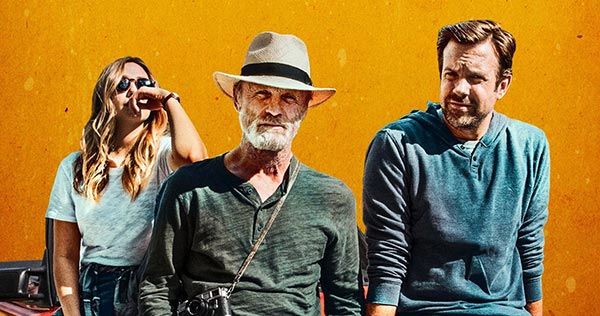
Kodachrome Ratings: IMDB: 6.8 – Rotten Tomatoes: 71%/6.9 – Metacritic: 57%/7.5 (Photogpedia Score: 6.8)
Matt (Jason Sudeikis) a struggling music executive drives his estranged and dying father Benjamin (Ed Harris), a famous photojournalist cross country to deliver four old rolls of Kodachrome film to the last lab in the world that can develop them before it closes for good. Along with Ben’s nurse Zooey (Elizabeth Olsen), the three navigate a world-changing from analog to digital while trying to put the past behind them.
Kodachrome is based on the 2010 New York Times article For Kodachrome Fans, Road Ends at Photo Lab in Kansas by A.G. Sulzberger.
34. One Hour Photo (2002)
One Hour PhotoRatings: IMDB: 6.8 – Rotten Tomatoes: 81%/6.4 – Metacritic: 64%/5.2 (Photogpedia Score: 6.6)
This dark thriller features Robin Williams playing a lonely one-hour photo clerk who stalks a family whose pictures he regularly develops.
One Hour Photo is a very well-made thriller. Robin Williams is incredible as creepy Sy “the photo guy”. The thing that makes this movie so terrifying is that you know there are people like Sy out there.
35. The Secret Life of Walter Mitty (2013)
The Secret Life of Walter Mitty Ratings: IMDB: 7.3 – Rotten Tomatoes: 51%/7.1 – Metacritic: 54%/7.5 (Photogpedia Score: 6.6)
Walter Mitty (Ben Stiller) is a negative assets manager for Life Magazine. When he loses a vital negative needed for Life’s final issue, he sets off to find the photographer responsible, who could be anywhere in the world.
Mitty’s journey to find Sean O’Connell (Sean Penn) turns into an adventure of a lifetime, and something more extraordinary than anything he could have ever imagined.
36. Pecker (1998)
Pecker Ratings: IMDB: 6.3 – Rotten Tomatoes: 52%/6.4 – Metacritic: 66%/7.4 (Photogpedia Score: 6.4)
Sandwich Shop worker Pecker is obsessed with photography and snaps everything he sees around him.
One day he is discovered by a savvy art dealer from New York who views the youngster as a fresh talent worth entertaining. Never mind that his photographs are amateurish, grainy, and out-of-focus; they strike a chord with the New York’s artsy crowd.
As his success and fame grow, Pecker finds himself less welcome in his hometown and decides to turn the tables on the elitist art snobs of the city.
This is nothing more than a light-hearted comedy about the pretentiousness of fine-art photography. It features, two or three mildly amusing scenes in the first half of the movie, but overall there’s not much to hold the audience’s attention. The movie is also filled with cameos, the most notable one is Cindy Sherman. Plenty of people who have enjoyed this film, so it all comes down to taste.
37. Palermo Shooting (2008)
Palermo Shooting Ratings: IMDB: 6.2 – Rotten Tomatoes: 6.2 – Metacritic: N.A. (Photogpedia Score: 6.2)
Wim Wenders’ drama about a famous German photographer who narrowly avoids death in a road accident. Overworked and burnt out, he decides to go on a soul searching to Italy. In Palermo, he finds a new life and a new love, while being targeted by death.
The film’s pretentious philosophical musings, preachy dialogue, and ludicrous plot are pretty over the top, even by Wender’s standards. Thankfully, it’s a stylishly shot film that raises some important questions about life and death, which is a complex subject we can all relate to.
The weakest link though is Wender’s choice of Campino as Finn the photographer. I’ve seen a doorknob with better acting range. Calling him wooden would be too generous. Anything he says sounds like a line from the script, and the script is weak enough, to begin with. Luckily Giovanna Mezzogiorno and Dennis Hooper also feature in the film. Milla Jovovich also puts in a cameo appearance.
38. Gentleman’s Relish (2001)
Gentleman’s Relish Ratings: IMDB: 6.2 – Rotten Tomatoes: N.A. – Metacritic: N.A. (Photogpedia Score: 6.2)
In this comedy set in early 20th-century London, frustrated artist Kingdom Swann (Billy Connolly) is given a life-changing gift of a camera from his housekeeper. With the help of his new assistant, he starts a new career in photography.
Swann successfully photographs society pictures until two sisters ask him to photograph them in the nude. His assistant encourages him to specialize in “tableaux”: photographic versions of famous paintings of nudes, using local prostitutes as his models. Realizing the potential of the photos, his assistant secretly prints selected parts of the images and sells them to a supplier of pornography.
39 Fotograf (2015)
Movie Ratings: IMDB: 6.2 – Rotten Tomatoes: N.A. – Metacritic: N.A. (Photogpedia Score: 6.2)
Fotograf is a film based on his life and work of Czech photographer Jan Saudek. The biopic, which is co-written by Saudek, stars Karel Roden as the photographer.
The only thing this film did was leave me with a headache. I’ll admit I didn’t know anything about Saudek before watching this, and by the end of it, I didn’t want to know anymore.
Typically films about photographers are beautifully photographed and have at least one thing I like about them but that isn’t the case with Fotograf. The Dialogue is forced, characters are too theatrical and the editing, especially of the flashbacks are terrible. I wouldn’t go out of your way to watch this one.
40. Harrison’s Flowers (2000)
Harrison Flowers Ratings: IMDB: 7.1 – Rotten Tomatoes: 49%/7.6 – Metacritic: 49%/5.5 (Photogpedia Score: 6.2)
An American wife (McDowell) travels to war-torn Yugoslavia during the midst of civil war in 1991, to find her husband, a photojournalist for Newsweek, who has been reported missing. She teams up with two other photographers, played by Adrian Brody and Brendan Gleeson to find her husband and save him from a hotbed of genocide.
A Pulitzer Prize-winning photojournalist, Harrison (well played by David Straithairn), is envied and even despised by some of his younger colleagues. The film captures the competitiveness of photojournalism, the petty and not so petty rivalry among peers with the subjects they cover, the relative dangers, and the kinds of photos produced.
The only negative is the casting of Andie McDowell as Sarah. For the film to be effective, it calls for an actress with a forceful presence, such as Julianne Moore, Cate Blanchett or Kate Winslett. Unfortunately, lacking an expressive face, the few close-ups of McDowell don’t do much to illuminate Sarah’s inner conflicts and her gaining of a more mature, realistic, and alert political consciousness.
That said, this is still a beautifully shot film with an authentic look. Harrison Flowers is a fascinating movie that is worth adding to your watchlist.
41. The Public Eye (1992)
Movie Ratings: IMDB: 6.5 – Rotten Tomatoes: 63%/5.3 – Metacritic: N.A. (Photogpedia Score: 6.2)
The Public Eye is a noir thriller set in New York in l942, which follows Leon Bernstein (Joe Pesci), a tabloid photographer whose camera captures it all. The “Great Bernzini” as he’s called for his uncanny ability to arrive first on the scene of murders, is an unforgettable character.
Armed with a police radio and a portable darkroom, Bernzy hunts the nightclubs and alleys in search of a murder, a fire, a drunken celebrity – any image he can quickly photograph and sell for a few quick bucks.
Then the glamorous Kay Levitz (played wonderfully by Barbara Hershey) turns to him when the Mob seems to be muscling in on the club she owns. Bernstein agrees to help, believing that they’ll be some good photos in it for him. Instead, he ends up falling in love with Kay.
Inspired by the lives of tabloid photographers (specifically Weegee), director Howard Franklin combines black and white vignettes (like tabloid photographs brought to life) with a rich and memorable cast of characters. The Public Eye also features some of Weegee’s photos which is a nice touch. You’ll see plenty of 4×5 Graflex press cameras in the underrated gem of a film.
42. The Bang Bang Club
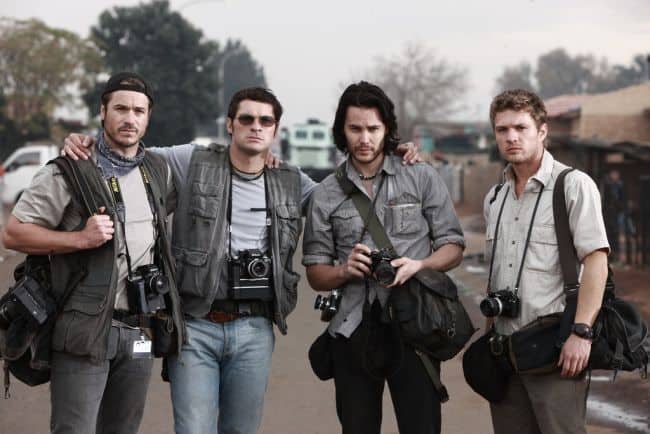
The Bang Bang Club Ratings: IMDB: 7.0 – Rotten Tomatoes: 49%/6.0 – Metacritic: 48%/6.0 (Photogpedia Score: 6.0)
Based on real-life events, The Bang Bang Club is an action-drama film about four photographers (Kevin Carter, Ken Oosterbroek, João Silva and Greg Marinovich) as they document the conflict in Apartheid in South Africa between 1990 and 1994.
While it’s been criticized for not exploring the politics involved and the bigger picture, it does a great job of capturing the realities of life as a conflict photographer and the horrors of the Apartheid.
43. Triage (2009)
Triage Ratings: IMDB: 6.5 – Rotten Tomatoes: 53% – Metacritic: N.A. (Photogpedia Score: 5.9)
In 1988, War photographer’s Mark Walsh (Colin Farrell) and his best friend David (Jamie Sives) are on assignment in war-torn Kurdistan.
Whilst there they are, witness, to the terrifying realities of war. When an explosion goes off, Mark is seriously injured, and he returns home to his wife Elena (Paz Vega) leaving David behind.
His wife is concerned as she watches Mark struggle to readjust and calls in her psychiatrist Grandfather Joaquin (Christopher Lee), who once treated war criminals.
Based on the novel of the same name by American war correspondent Scott Anderson, Triage is a chilling tale of the post-traumatic stress experienced by conflict photographers and soldiers.
44. Life (2015)
Life Ratings: IMDB: 6.0 – Rotten Tomatoes: 65%/4.4 – Metacritic: 59%/5.3 (Photogpedia Score: 5.7)
Directed by Anton Corbijn, this film biopic tells the story of Dennis Stock (Robert Pattinson), a Life Magazine photographer and his friendship with rising movie star James Dean (Dane DeHaan). Life is a period drama that focuses on how the magazine got its iconic photo spread with Dean in 1955, before the actor’s death at just 24.
45. Femme Fatale (2002)
Femme Fatale Ratings: IMDB: 6.2 – Rotten Tomatoes: 49%/4.9 – Metacritic: 59%/5.8 (Photogpedia Score: 5.7)
Brian De Palma’s Femme Fatale is a contemporary film noir about a former jewel thief and con woman trying to live the straight life.
Laure Ash (Rebecca Romijn) helps pull off a diamond robbery in Cannes the week of the annual film festival. She double-crosses her partners and makes off with the diamonds to Paris where she accidentally assumes the identity of a woman who commits suicide. We next skip ahead seven years and Laure (now called Lily Watts) re-surfaces as the wife of the new American ambassador to France. Enter paparazzi photographer Nicolas Bardo (Antonio Banderas) who takes Laure’s picture. This sets the stage for the rest of the movie, as Laure goes back to her old ways, and does whatever it takes to protect her former identity and stop the past from coming back to haunt her.
There are plenty of positives with the movie. The excellent long opening sequences are done almost entirely without dialogue and the ending (which is the best part of the film) provides DePalma’s signature twist. The film is also beautifully photographed.
Femme Fatale is sexy, seductive, but not DePalma’s best film. Yes, it has some moments of brilliance, but for some, these flashes of cinematic mastery are not enough. Unless you’re a fan of DePalma’s other movies or Antonio Banderas then I’d give this one a miss.
46. We’ll Take Manhattan (2012)
Movie Ratings: IMDB: 6.8 – Rotten Tomatoes: 4.5 – Metacritic: N.A. (Photogpedia Score: 5.7)
We’ll Take Manhattan tells the real-life story of the 1960s love affair between photographer David Bailey (Aneurin Barnard) and model Jean Shrimpton (Karen Gillan). The focus of the film is the iconic New York assignment for British Vogue in 1962 and the conflict between Bailey and fashion editor Lady Clare (played excellently by Helen McCory).
47. Fur: An Imaginary Portrait of Diane Arbus (2006)
Fur Ratings: IMDB: 6.5 – Rotten Tomatoes: 32%/6.3 – Metacritic: 50%/5.4 (Photogpedia Score: 5.5)
An original but seriously flawed film, Fur: An Imaginary Portrait of Diane Arbus, aims to show the career of Diane Arbus, one of the greatest photographers of the last century, by centering on one crucial encounter between Diane (Nicole Kidman) and a fictional character named Lionel (Robert Downey), a misfit who helps Arbus express her demons and channel them into art.
Loosely inspired on the book Diane Arbus: A Biography, written in 1984 by Patricia Bosworth (also a producer), the film is book-ended by Diane Arbus’ visit to a nudist camp. Don’t treat the film as fact, though: the story is mainly fictional, and the Diane Arbus estate refused to give their approval (I don’t blame them.)
Okay, so the first time I watched this, I turned it off after about twenty minutes. When researching this article, I forced myself to sit through it again. It was painful. I wanted to like it, but I honestly believe this is the worst movie on the list.
Beauty and the Beast
If you watch the film expecting an entertaining biography about Diane Arbus then you’re going to be grossly disappointed. Now, if you’re looking for a romantic comedy about a bored housewife who has an affair with Chewbacca then this is a film for you. A variation of Beauty and the Beast gone wrong.
The only good thing about the movie was the end credits. The rest of the film was awful. I think Nicole Kidman is one of the best actresses in the business, but she couldn’t even save this film. Truth be told, she is miscast as Arbus. There was nothing likable about her character, and by the end of the film, I actually disliked her (not good for your protagonist). Not only was the film badly written but it was overacted and poorly directed.
48. Eyes of Laura Mars (1978)
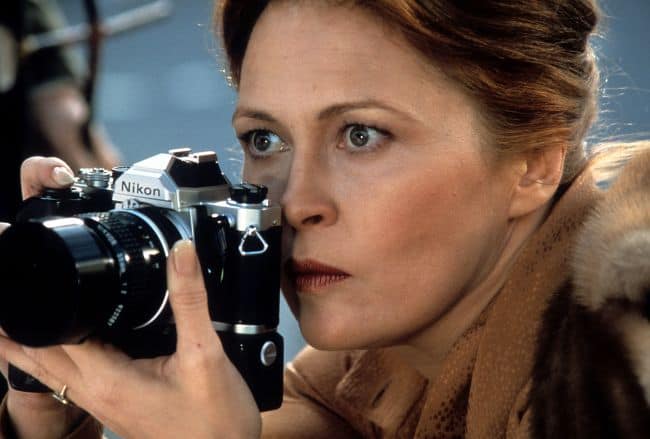
Movie Ratings: IMDB: 6.2 – Rotten Tomatoes: 46%/4.3 – Metacritic: 49% (Photogpedia Score: 5.2)
Eyes of Laura Mars is a thriller centered on fashion photographer Laura (Faye Dunaway), who’s being terrorized by psychic visions of horrific murders. Worse still, she sees them through the eyes of the killer. The film has a good original premise but sadly suffers from a thin plot.
The Laura Mars character was heavily influenced by Helmut Newton’s work and he even provided photos to be used in the film. Dunaway’s portrayal of a photographer is spot on and makes watching this film worthwhile. Tommy-Lee Jones is also excellent as John Neville.
The problem with the film though is the lack of suspense. Anyone can guess who the murderer is within the first ten minutes. The film also starts off well but loses its way half-way through. I would also love to know how Laura got her telepathic abilities too?
Overall, it’s an entertaining movie, and I can see why it’s a cult favorite. Would I recommend the Eyes of Laura Mars? Probably, because it has the talented and beautiful Faye Dunaway in it, a good soundtrack and features Helmut Newton’s photos.
49. Mapplethorpe (2018)
Mapplethorpe Ratings: IMDB: 6.1 – Rotten Tomatoes: 31%/6.4 – Metacritic: 42%/4.5 (Photogpedia Score: 5.1)
A film chronicling the life and career of photographer Robert Mapplethorpe (played by Matt Smith) from his rise to fame in the 1970s to his death at the age of 42 in 1989.
There’s a reason this movie is near the bottom of this list. The less said about it the better.
50. Friday Foster (1975)
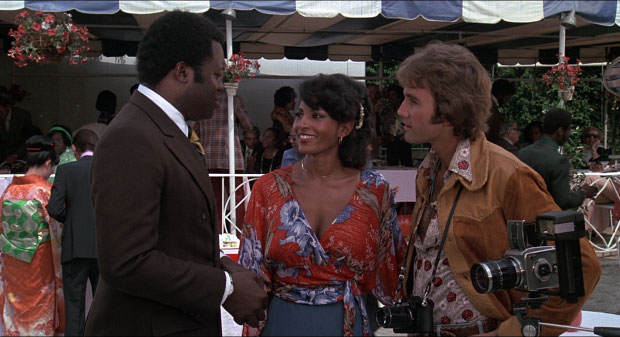
Movie Ratings: IMDB: 6.0 – Rotten Tomatoes: 3.9 – Metacritic: N.A. (Photogpedia Score: 5.0)
Friday Foster (Pam Grier), a photographer for a magazine in Los Angeles, is sent on assignment to get pictures of a reclusive billionaire who is arriving in secret at a nearby airport. It turns out she’s not the only one taking shots as she witnesses and photographs an assassination attempt on her subject. Fortunate to get out alive, she finds herself getting deeper and deeper into the dangerous situation. With the photos in her possession, she becomes a target for the murderers. Teaming up with a private eye, Foster sets out to discover the truth behind the assassination attempt.
Despite a great premise, the script is a little weak and the plot lacks focus. Pam Grier is excellent though and she is supported by a solid cast including Carl Weathers (Apollo Creed in Rocky) and Scatman Crothers. Friday Foster is an underrated film with an interesting premise that deserves to be higher up on this list (well above Mapplethorpe anyway.)
Ranking the Movies
All movies are given an overall score out of 10. To work out this score, I combined ratings from the three most popular movie review websites: IMDB, Rotten Tomatoes and Metacritic and then worked out an average.
IMDB Rating + Rotten Tomatoes Average Rating (Critic/Audience) + Metacritic Average Rating (Critic/Audience) = Combined Rating
I then divided the combined rating by the number of websites that reviewed the film (normally all three of them).
Combined Rating/Websites = Average Rating and Photogpedia Score
These ratings are derived from both audience and critics. Click here to see an image of my spreadsheet to get a better understanding of how the movies were ranked. Ratings were last checked on the 31st of January 2020.
Final Words
This concludes our list of photography movies. If we’re missing any, then leave a comment in the section below and we’ll check it out. Also, let us know which photography movie is your favorite and how many movies from the list you’ve seen.
If you found the list helpful then we would be grateful if you could share the post with others. Thanks for reading.

